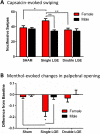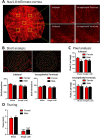Lacrimal gland excision in male and female mice causes ocular pain and anxiety-like behaviors
- PMID: 33057056
- PMCID: PMC7560880
- DOI: 10.1038/s41598-020-73945-w
Lacrimal gland excision in male and female mice causes ocular pain and anxiety-like behaviors
Abstract
Lacrimal gland excision (LGE) induced dry eye produces more severe corneal damage in female mice, yet signs of LGE-induced ocular pain and anxiety in male and female mice have not been characterized. Excision of either the extraorbital gland (single LGE), or both the extraorbital and intraorbital glands (double LGE) was performed in male and female C57BL/6J mice to induce moderate and severe dry eye. Ongoing pain was assessed by quantifying palpebral opening and evoked nociceptive responses after corneal application of capsaicin and menthol. The open-field and plus maze were used to assess anxiety. Single LGE caused a reduction in palpebral opening and an increase in capsaicin and menthol-evoked responses only in female mice. Furthermore, single LGE produced signs of increased anxiety in female but not male mice. Overall, female mice appear more susceptible to signs of ocular pain, irritation, and anxiety in response to aqueous tear deficiency.
Conflict of interest statement
The authors declare no competing interests.
Figures






References
-
- Tian YJ, et al. Epidemiologic study of dry eye in populations equal or over 20 years old in Jiangning District of Shanghai. Chinese J. Ophthalmol. 2009;45:486–491. - PubMed
Publication types
MeSH terms
Substances
Grants and funding
LinkOut - more resources
Full Text Sources
Medical
Molecular Biology Databases

